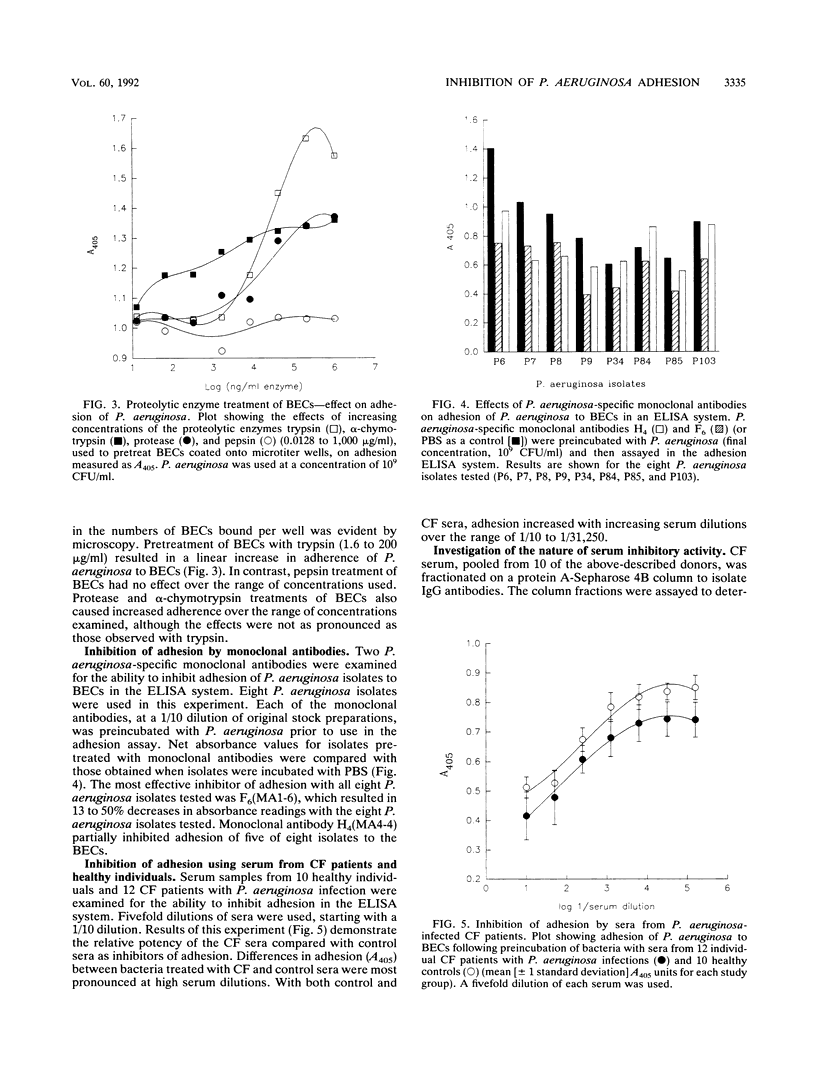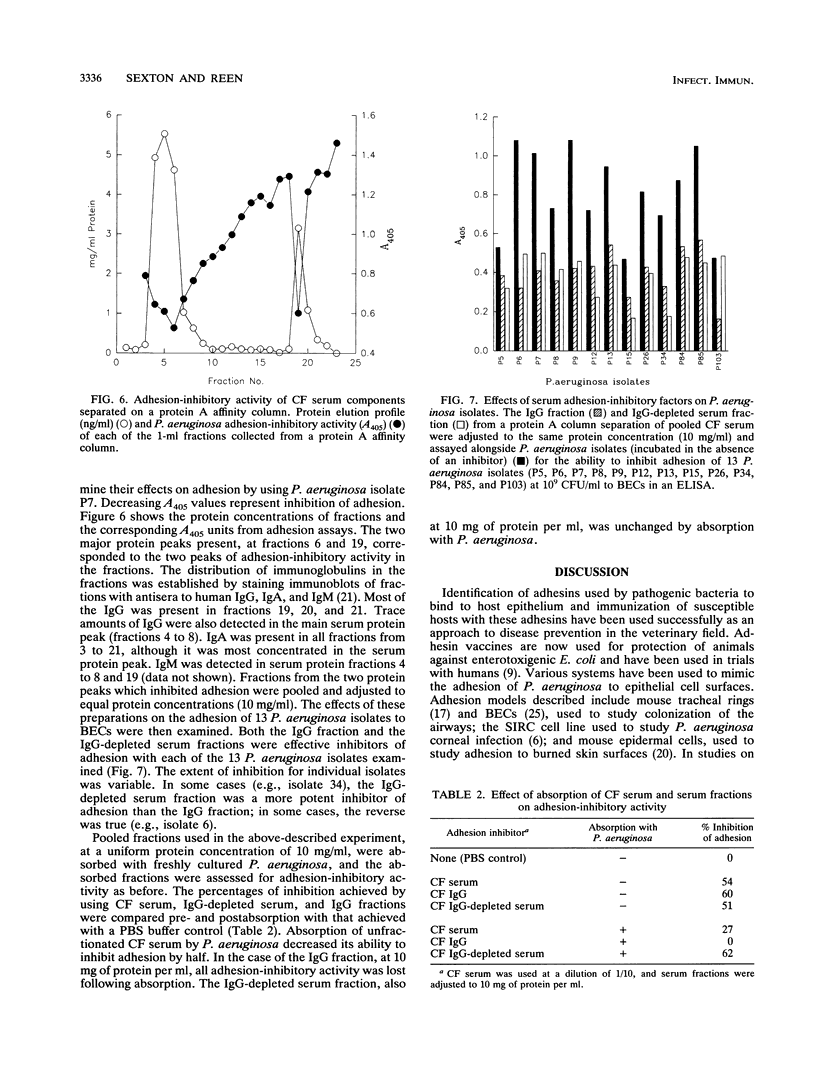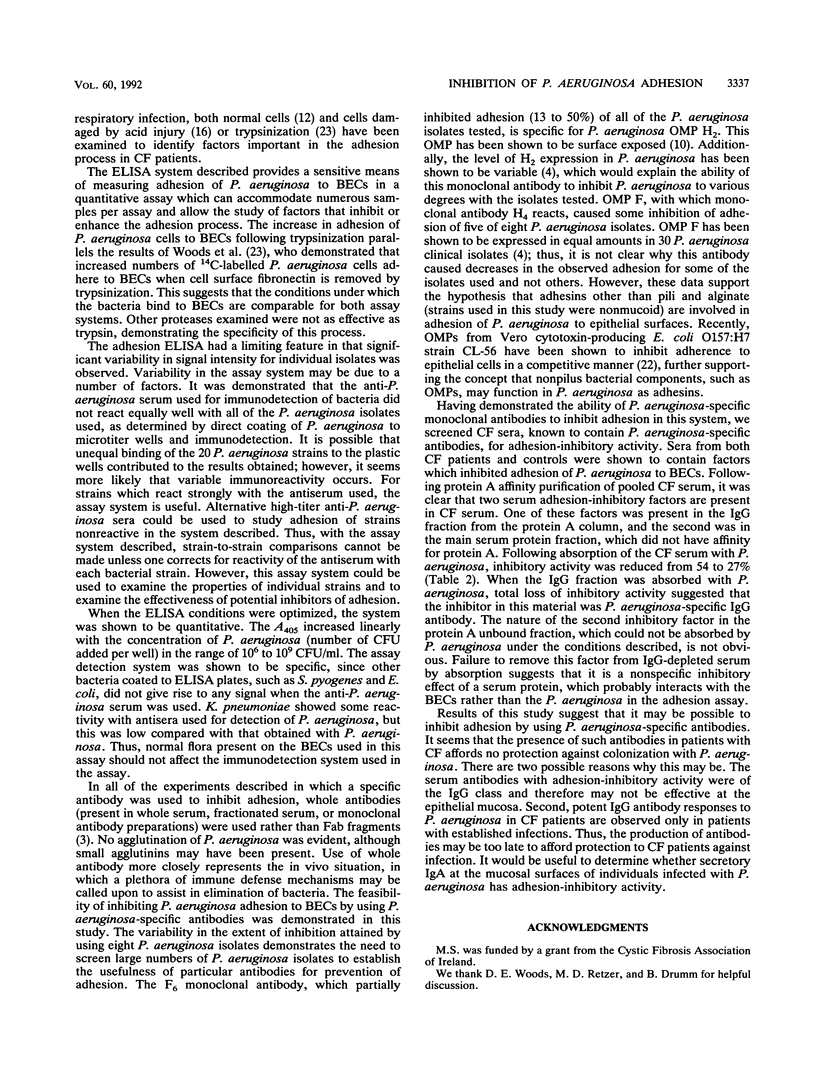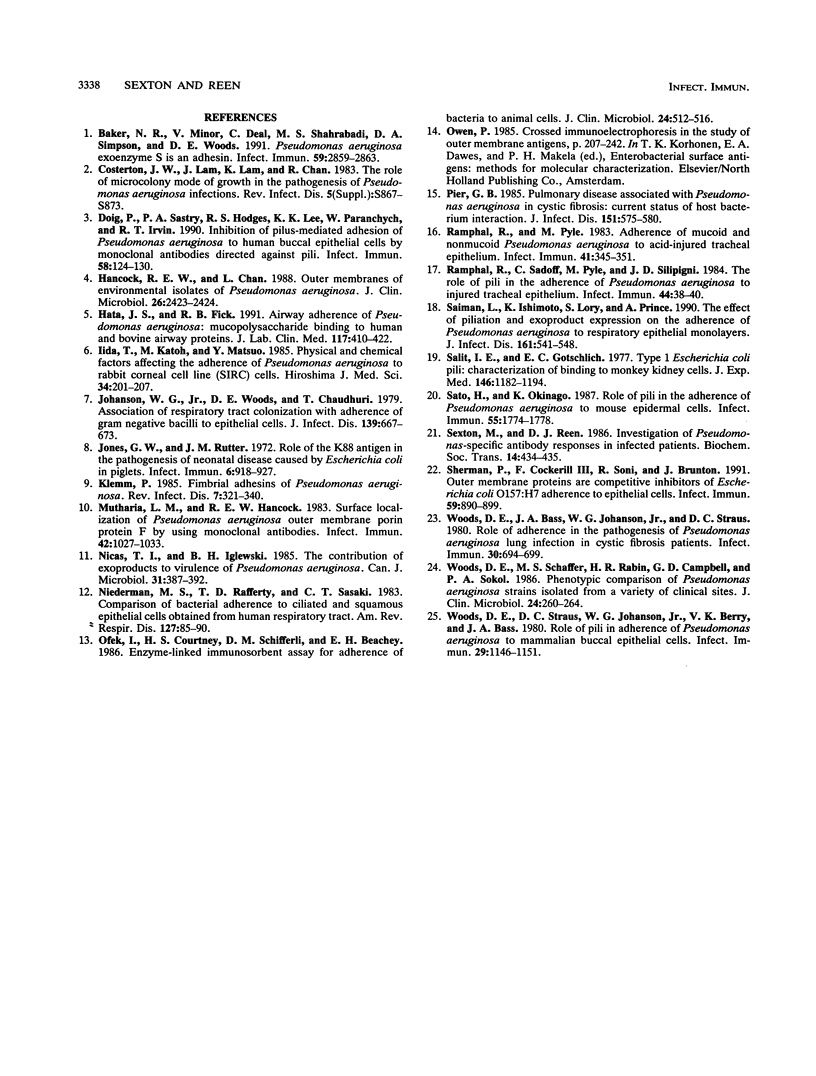Abstract
An enzyme-linked immunosorbent assay system was developed and used to study adhesion of Pseudomonas aeruginosa to human epithelial cells and the abilities of specific antibodies to inhibit this process. Human buccal epithelial cells coated onto microtiter plates were incubated with P. aeruginosa suspensions, and adherent bacteria were detected by using anti-P. aeruginosa serum and a horseradish peroxidase-conjugated secondary antiserum. Adhesion, quantitated as an increase in A405, varied linearly with increasing numbers of bacterial CFU added per well in the range of 10(5) to 10(8) CFU per well. Adhesion of P. aeruginosa increased following trypsinization of buccal epithelial cells. Preincubation of bacteria with monoclonal antibodies directed against P. aeruginosa outer membrane protein H2 inhibited adhesion with all eight of the isolates tested. Preincubation of P. aeruginosa with sera from infected cystic fibrosis patients also resulted in inhibition of adhesion in the enzyme-linked immunosorbent assay system. This inhibitory activity was shown to be due to two factors: P. aeruginosa-specific immunoglobulin G and a non-immunoglobulin G serum component. These data support the hypothesis that bacterial components other than pili are involved in adhesion and suggest that anti-P. aeruginosa antibodies may be of use in preventing adhesion and subsequent colonization with P. aeruginosa.
Full text
PDF






Selected References
These references are in PubMed. This may not be the complete list of references from this article.
- Baker N. R., Minor V., Deal C., Shahrabadi M. S., Simpson D. A., Woods D. E. Pseudomonas aeruginosa exoenzyme S is an adhesion. Infect Immun. 1991 Sep;59(9):2859–2863. doi: 10.1128/iai.59.9.2859-2863.1991. [DOI] [PMC free article] [PubMed] [Google Scholar]
- Costerton J. W., Lam J., Lam K., Chan R. The role of the microcolony mode of growth in the pathogenesis of Pseudomonas aeruginosa infections. Rev Infect Dis. 1983 Nov-Dec;5 (Suppl 5):S867–S873. doi: 10.1093/clinids/5.supplement_5.s867. [DOI] [PubMed] [Google Scholar]
- Doig P., Sastry P. A., Hodges R. S., Lee K. K., Paranchych W., Irvin R. T. Inhibition of pilus-mediated adhesion of Pseudomonas aeruginosa to human buccal epithelial cells by monoclonal antibodies directed against pili. Infect Immun. 1990 Jan;58(1):124–130. doi: 10.1128/iai.58.1.124-130.1990. [DOI] [PMC free article] [PubMed] [Google Scholar]
- Hancock R. E., Chan L. Outer membranes of environmental isolates of Pseudomonas aeruginosa. J Clin Microbiol. 1988 Nov;26(11):2423–2424. doi: 10.1128/jcm.26.11.2423-2424.1988. [DOI] [PMC free article] [PubMed] [Google Scholar]
- Hata J. S., Fick R. B., Jr Airway adherence of Pseudomonas aeruginosa: mucoexopolysaccharide binding to human and bovine airway proteins. J Lab Clin Med. 1991 May;117(5):410–422. [PubMed] [Google Scholar]
- Iida T., Katoh M., Matsuo Y. Physical and chemical factors affecting the adherence of Pseudomonas aeruginosa to a rabbit cornea cell line (SIRC) cells. Hiroshima J Med Sci. 1985 Jun;34(2):201–207. [PubMed] [Google Scholar]
- Johanson W. G., Jr, Woods D. E., Chaudhuri T. Association of respiratory tract colonization with adherence of gram-negative bacilli to epithelial cells. J Infect Dis. 1979 Jun;139(6):667–673. doi: 10.1093/infdis/139.6.667. [DOI] [PubMed] [Google Scholar]
- Jones G. W., Rutter J. M. Role of the K88 antigen in the pathogenesis of neonatal diarrhea caused by Escherichia coli in piglets. Infect Immun. 1972 Dec;6(6):918–927. doi: 10.1128/iai.6.6.918-927.1972. [DOI] [PMC free article] [PubMed] [Google Scholar]
- Klemm P. Fimbrial adhesions of Escherichia coli. Rev Infect Dis. 1985 May-Jun;7(3):321–340. doi: 10.1093/clinids/7.3.321. [DOI] [PubMed] [Google Scholar]
- Mutharia L. M., Hancock R. E. Surface localization of Pseudomonas aeruginosa outer membrane porin protein F by using monoclonal antibodies. Infect Immun. 1983 Dec;42(3):1027–1033. doi: 10.1128/iai.42.3.1027-1033.1983. [DOI] [PMC free article] [PubMed] [Google Scholar]
- Nicas T. I., Iglewski B. H. The contribution of exoproducts to virulence of Pseudomonas aeruginosa. Can J Microbiol. 1985 Apr;31(4):387–392. doi: 10.1139/m85-074. [DOI] [PubMed] [Google Scholar]
- Niederman M. S., Rafferty T. D., Sasaki C. T., Merrill W. W., Matthay R. A., Reynolds H. Y. Comparison of bacterial adherence to ciliated and squamous epithelial cells obtained from the human respiratory tract. Am Rev Respir Dis. 1983 Jan;127(1):85–90. doi: 10.1164/arrd.1983.127.1.85. [DOI] [PubMed] [Google Scholar]
- Ofek I., Courtney H. S., Schifferli D. M., Beachey E. H. Enzyme-linked immunosorbent assay for adherence of bacteria to animal cells. J Clin Microbiol. 1986 Oct;24(4):512–516. doi: 10.1128/jcm.24.4.512-516.1986. [DOI] [PMC free article] [PubMed] [Google Scholar]
- Pier G. B. Pulmonary disease associated with Pseudomonas aeruginosa in cystic fibrosis: current status of the host-bacterium interaction. J Infect Dis. 1985 Apr;151(4):575–580. doi: 10.1093/infdis/151.4.575. [DOI] [PubMed] [Google Scholar]
- Ramphal R., Pyle M. Adherence of mucoid and nonmucoid Pseudomonas aeruginosa to acid-injured tracheal epithelium. Infect Immun. 1983 Jul;41(1):345–351. doi: 10.1128/iai.41.1.345-351.1983. [DOI] [PMC free article] [PubMed] [Google Scholar]
- Ramphal R., Sadoff J. C., Pyle M., Silipigni J. D. Role of pili in the adherence of Pseudomonas aeruginosa to injured tracheal epithelium. Infect Immun. 1984 Apr;44(1):38–40. doi: 10.1128/iai.44.1.38-40.1984. [DOI] [PMC free article] [PubMed] [Google Scholar]
- Saiman L., Ishimoto K., Lory S., Prince A. The effect of piliation and exoproduct expression on the adherence of Pseudomonas aeruginosa to respiratory epithelial monolayers. J Infect Dis. 1990 Mar;161(3):541–548. doi: 10.1093/infdis/161.3.541. [DOI] [PubMed] [Google Scholar]
- Salit I. E., Gotschlich E. C. Type I Escherichia coli pili: characterization of binding to monkey kidney cells. J Exp Med. 1977 Nov 1;146(5):1182–1194. doi: 10.1084/jem.146.5.1182. [DOI] [PMC free article] [PubMed] [Google Scholar]
- Sato H., Okinaga K. Role of pili in the adherence of Pseudomonas aeruginosa to mouse epidermal cells. Infect Immun. 1987 Aug;55(8):1774–1778. doi: 10.1128/iai.55.8.1774-1778.1987. [DOI] [PMC free article] [PubMed] [Google Scholar]
- Sherman P., Cockerill F., 3rd, Soni R., Brunton J. Outer membranes are competitive inhibitors of Escherichia coli O157:H7 adherence to epithelial cells. Infect Immun. 1991 Mar;59(3):890–899. doi: 10.1128/iai.59.3.890-899.1991. [DOI] [PMC free article] [PubMed] [Google Scholar]
- Woods D. E., Bass J. A., Johanson W. G., Jr, Straus D. C. Role of adherence in the pathogenesis of Pseudomonas aeruginosa lung infection in cystic fibrosis patients. Infect Immun. 1980 Dec;30(3):694–699. doi: 10.1128/iai.30.3.694-699.1980. [DOI] [PMC free article] [PubMed] [Google Scholar]
- Woods D. E., Schaffer M. S., Rabin H. R., Campbell G. D., Sokol P. A. Phenotypic comparison of Pseudomonas aeruginosa strains isolated from a variety of clinical sites. J Clin Microbiol. 1986 Aug;24(2):260–264. doi: 10.1128/jcm.24.2.260-264.1986. [DOI] [PMC free article] [PubMed] [Google Scholar]
- Woods D. E., Straus D. C., Johanson W. G., Jr, Berry V. K., Bass J. A. Role of pili in adherence of Pseudomonas aeruginosa to mammalian buccal epithelial cells. Infect Immun. 1980 Sep;29(3):1146–1151. doi: 10.1128/iai.29.3.1146-1151.1980. [DOI] [PMC free article] [PubMed] [Google Scholar]


